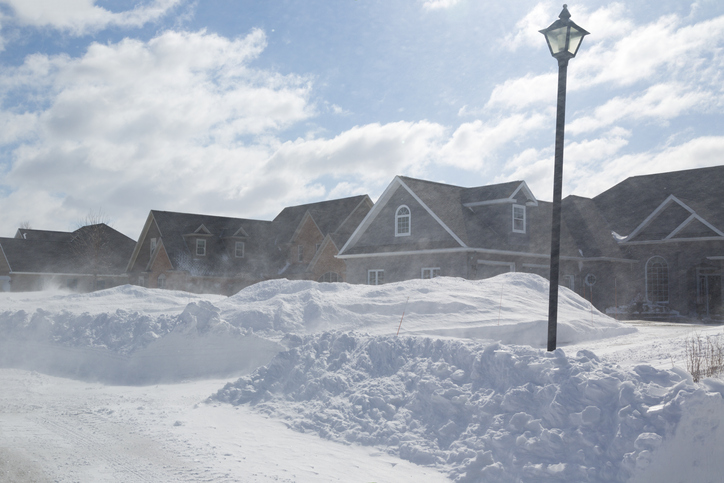Click here to Subscribe to Chips Tips Blog
Tips to Winterize Your Water Heater, Plumbing & Sump Pump

Every year at about this time, eager meteorologists vie to be the first to forecast what the winter season has in store.
This year, Ontario is expected to get slammed with winter storms, rain, ice, sleet and snow. Farmer’s Almanac even goes so far as to label the season as “freezing, frigid and frosty.” Brrr!!!
Since Canadian winters tend to be memorable even on the milder end, this is likely not the best news you’ve received today.
But in a way it is good, because you can use this information now to winterize your home and vulnerable appliances and equipment before it becomes too cold to do so safely. In this post, learn what to do to winterize your water heater, plumbing and sump pump now.
Winterize Your Water Heater
Your water heater has a tough job to do on any given day. It is tasked with delivering hot water when you want it in the quantity you want it.
But when temperatures plunge, your water heater’s job becomes more challenging. This is because the water is that much colder when it first arrives for heating.
The harder your water heater has to work to heat up the water you need, the more power it will draw and the more you will spend for your hot water this winter.
What can you do to make your water heater’s job easier (and help your wallet take a load off to boot)? Happily, you can do quite a lot!
Here are the steps we recommend taking before winter arrives again.
-
Drain your water heater completely.
-
Run water through to ensure all sediment and mineral buildup is drained out.
-
Check the pressure relief valve for leaks by opening it and listening for a “hiss.”
-
Insulate your hot water heater tank and lines to retain heat.
If you have an older water heater or you have inherited a water heater that has an uncertain maintenance history, we recommend scheduling a plumbing service call and safety inspection.
If your pressure relief valve is NOT hissing, this means there is a leak somewhere and a plumbing tune-up and repair are also recommended.
Winterize Your Pipes and Plumbing
With the freezing temperatures that occur during winter here in Canada, frozen, burst pipes are relatively commonplace. But burst pipes can end up causing some of the messiest, priciest home repairs you could ever dream up and you really want to avoid this.
Luckily, it is possible to a great degree. What you need to do is winterize your pipes and plumbing.
Here are the steps we recommend taking to protect vulnerable pipes and plumbing lines from winter freezes.
-
Identify areas where pipes run along exposed walls, under sinks, in attics or crawl spaces or in basement areas where insulation is thin or not present and add insulation in these areas to protect the pipes from freezing.
-
Add safe heat sources as is possible to keep semi-exposed pipes from freezing.
-
For outside pipes that experience direct cold exposure, wrap them in insulation.
-
Check each outdoor spigot for leaks and either shut off water to those spigots or replace with frost-free spigots.
-
Always disconnect and drain hoses that are connected to outdoor spigots and store the hoses for the winter.
We often receive calls from new homeowners who are not familiar with their home’s piping and plumbing system. We are happy to come out and do a pre-winter safety inspection and maintenance service to ensure your plumbing is protected this winter.
Winterize Your Sump Pump System
In most homes, the sump pump is tucked away in the basement and gets noticed only when it stops working properly.
But often, by this time, your basement and/or home has taken on water and you have an emergency on your hands. This can be especially the case during power outages, which often coincide with winter storms.
When power outages happen during the late winter and early spring thaw season, you risk a major flooding event without any real recourse.
Here are the steps we recommend to get your sump pump cleaned, prepped, tuned up and ready for winter.
-
Check the power cord and outlet and make sure the plug is GFCI-certified.
-
Visually inspect the exterior of the cord and the sump pump to be sure it is level.
-
Fill the sump pit with water and wait for the sump pump to cycle on.
-
Observe the sump pump in action and listen for any odd sounds or vibrations.
-
Remove the sump pump from the pit and inspect and clean the grate.
-
Check the drainage lines and connection points and ensure all is tight.
-
Clean the sump pump screen and inlet opening (if applicable).
-
Check that the drainage points away from your home’s foundation.
-
Check the same in your backup sump pump system.
If you do not currently have a backup sump pump system and your sump runs on electricity, you are in real danger of taking on water inside your basement and home if there is a power outage. In this case, we recommend adding a backup sump pump that runs on battery or generator power.
As a perk, making this upgrade may in turn lower your homeowner insurance premiums and will certainly increase the resale value of your home when that time comes.
If you do not have the time or comfort level to tend to your sump system’s maintenance needs, we are happy to take on this task for you.
Get in Touch
Contact us online or give us a call at 877-885-3403.
P.S. Don’t forget to sign up to receive Chip’s Tips by email each month - it's free!

